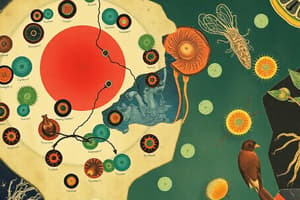Podcast
Questions and Answers
What is the basic unit of life?
What is the basic unit of life?
- Organ
- Cell (correct)
- Tissue
- Organism
Which part of the cell controls what enters and leaves?
Which part of the cell controls what enters and leaves?
- Cytoplasm
- Cell membrane (correct)
- Nucleus
- Cell wall
What do plant cells have that animal cells do not?
What do plant cells have that animal cells do not?
- Cell wall (correct)
- Ribosomes
- Nucleus
- Mitochondria
Which organelle is responsible for producing energy?
Which organelle is responsible for producing energy?
What is the function of the nucleus?
What is the function of the nucleus?
What is the jelly-like substance inside the cell called?
What is the jelly-like substance inside the cell called?
What structure enables plants to capture sunlight for photosynthesis?
What structure enables plants to capture sunlight for photosynthesis?
Which cellular structure is involved in transporting materials within the cell?
Which cellular structure is involved in transporting materials within the cell?
What is the primary role of ribosomes in the cell?
What is the primary role of ribosomes in the cell?
Why do plant cells have a defined shape?
Why do plant cells have a defined shape?
Flashcards
What is a cell?
What is a cell?
The basic, fundamental unit of life, which performs all life processes.
What does the nucleus do?
What does the nucleus do?
The control center of the cell, containing DNA and directing all cell activities.
What is the cell wall?
What is the cell wall?
A rigid, protective outer layer found in plant cells, providing shape and support.
What does the mitochondria do?
What does the mitochondria do?
Signup and view all the flashcards
What are ribosomes?
What are ribosomes?
Signup and view all the flashcards
What is the cell membrane?
What is the cell membrane?
Signup and view all the flashcards
What is the cytoplasm?
What is the cytoplasm?
Signup and view all the flashcards
What is endocytosis?
What is endocytosis?
Signup and view all the flashcards
What are chloroplasts?
What are chloroplasts?
Signup and view all the flashcards
What are unicellular organisms?
What are unicellular organisms?
Signup and view all the flashcards
Study Notes
Cell Structure and Function
- Basic Unit of Life: The cell is the basic unit of life.
- Cell Membrane: Controls what enters and leaves the cell.
- Plant Cells vs. Animal Cells: Plant cells have a cell wall, which animal cells lack. Plant cells also have chloroplasts for photosynthesis, absent in animal cells.
- Energy Production Organelle: Mitochondria are responsible for producing energy.
- Nucleus Function: The nucleus controls cell activities.
- Cell Theory: All living things are made up of cells.
Cell Processes and Characteristics
- Cell Membrane Function: The cell membrane is not rigid and allows movement.
- Chloroplasts Location: Chloroplasts are found in plant cells, not animal cells.
- Cell Division: Cells divide to reproduce.
- Prokaryotic vs. Eukaryotic Cells: Differences exist between these cell types. Prokaryotic cells are simpler.
- Cytoplasm: The jelly-like substance inside the cell.
- Cellular Nutrient Uptake: Cells take in nutrients by a process.
- Photosynthesis: Plant cells use photosynthesis to capture sunlight for energy.
- Intracellular Transport: Materials within the cell are transported.
Defining Structures
- Cells Shape: Cells shaped due to cell walls
- Cell Wall Function: Provides structural support and shape.
- Ribosomes: Protein synthesis occurs within the ribosomes, involved in cell function.
- Cell Membrane Role in Homeostasis: The membrane regulates internal environment by controlling what enters and exits the cell.
- Vacuole Function (Plant Cells): Helps regulate water balance and materials.
- Cell Size Effect on Function: Cell size affects a cell's function.
Specialized Cells and Processes
- Stem Cells: Function of stem cells and their importance
- Cell Communication: Cells communicate with each other in various ways
- Impact of Environment on Cell Function: The environment influences cell function.
- Cell Division Impact: Cell division is crucial for growth and repair.
- Organelle Functions: Organelles have specific functions within a cell.
- Cell Energy Production: Cells produce energy, and its importance in cells.
- Prokaryotic Cell Structure: A concise overview of prokaryotic cell structure.
Additional Notes
- Multiple Choice Questions: Covered.
- True/False Questions: Covered.
- Fill-in-the-Blank Questions: Covered.
- Open-Ended Questions: Covered, asking about the importance of cells in living organisms.
- Diagram-Based Questions: Covered, pertaining to plant & animal cells.
Studying That Suits You
Use AI to generate personalized quizzes and flashcards to suit your learning preferences.




